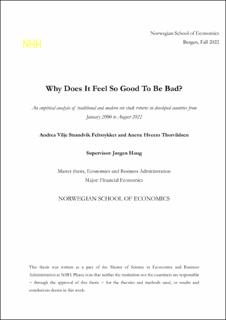| dc.description.abstract | This study aims to give managers and investors a better financial basis to assess whether they
should be exposed to sinful companies. Accordingly, this thesis examines the presence of alpha
for sin stocks in developed countries between January 2000 to August 2022. The study expands
on previous research and applies a contemporary definition of the sin industry that considers oil
and gas companies. Additionally, the study expands the observation period and the geographical
area beyond what has already been done and includes stricter stock criteria. With 412 identified
stocks for developed countries, this thesis has one of the most extensive sin stock samples to be
analysed to date.
Multi-factor models are applied to control for risk exposure variations between different valueweighted
portfolios. We estimate alphas by exploiting a long-short investment strategy by which
we are long sin and short in the market and then 2) short in the comparable portfolio.
Our results demonstrate an economically large and statistically significant alpha for both the
traditional and modern sin portfolio in excess of the market. The market risk-, profitability, and
investment factors explain the abnormal returns to some extent. Among the traditional sin
industries, gambling offers the highest alpha. However, the other industries also outperform the
market. For modern sin stocks, the value factor is crucial in explaining abnormal returns over the
entire period. Results detect an increase in modern sin stock alpha ex-post the divestment
movement, where the profitability factor explains some of the return premium. When we apply
the second long-short investment strategy for both traditional and modern sin stocks we find no
evidence of alpha. Thus, investors might earn a similar risk-adjusted return if they invest in a
comparable portfolio. Nevertheless, the expected excess return over market return is more
remarkable for sin stocks when compared against the non-sinful companies. | en_US |
